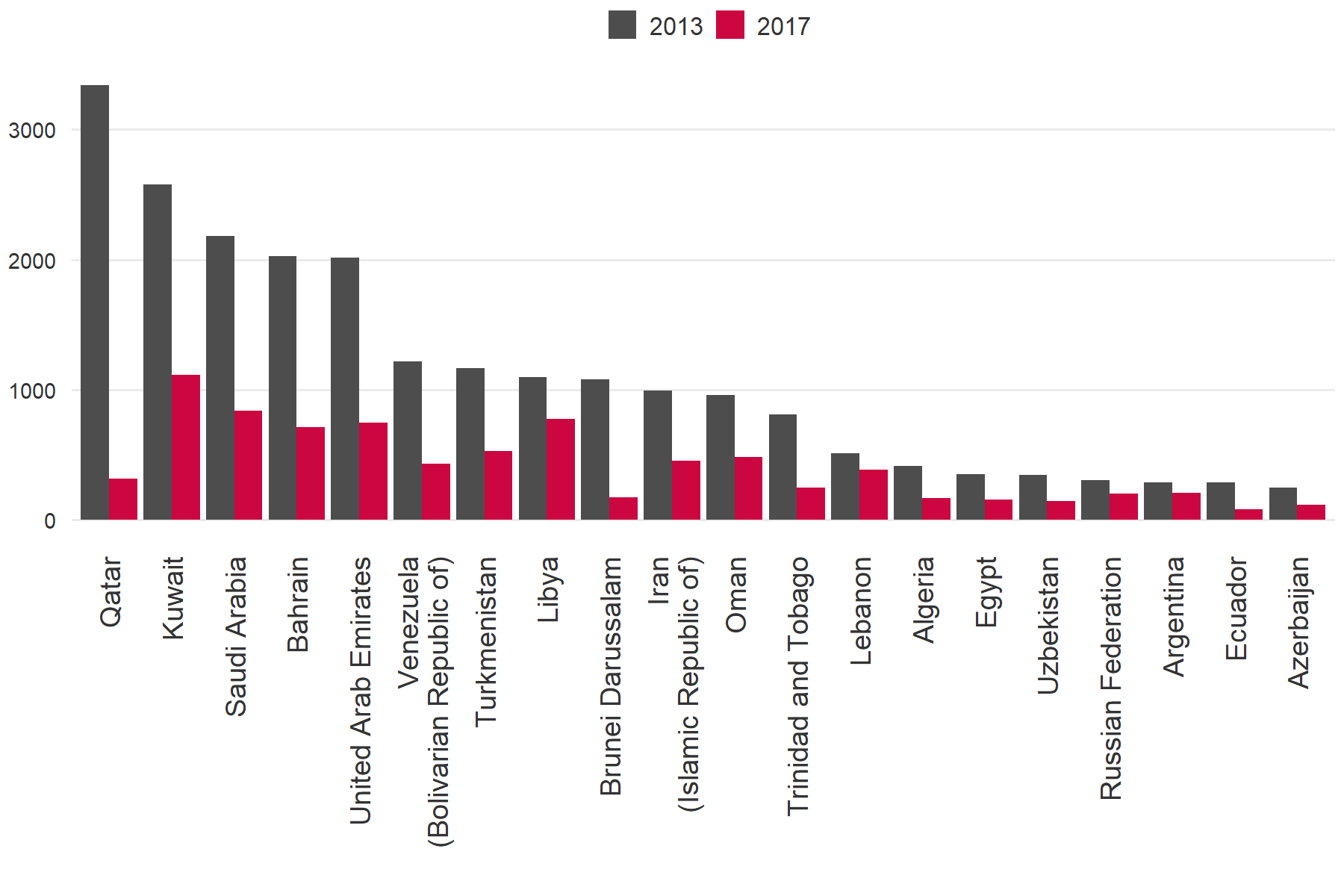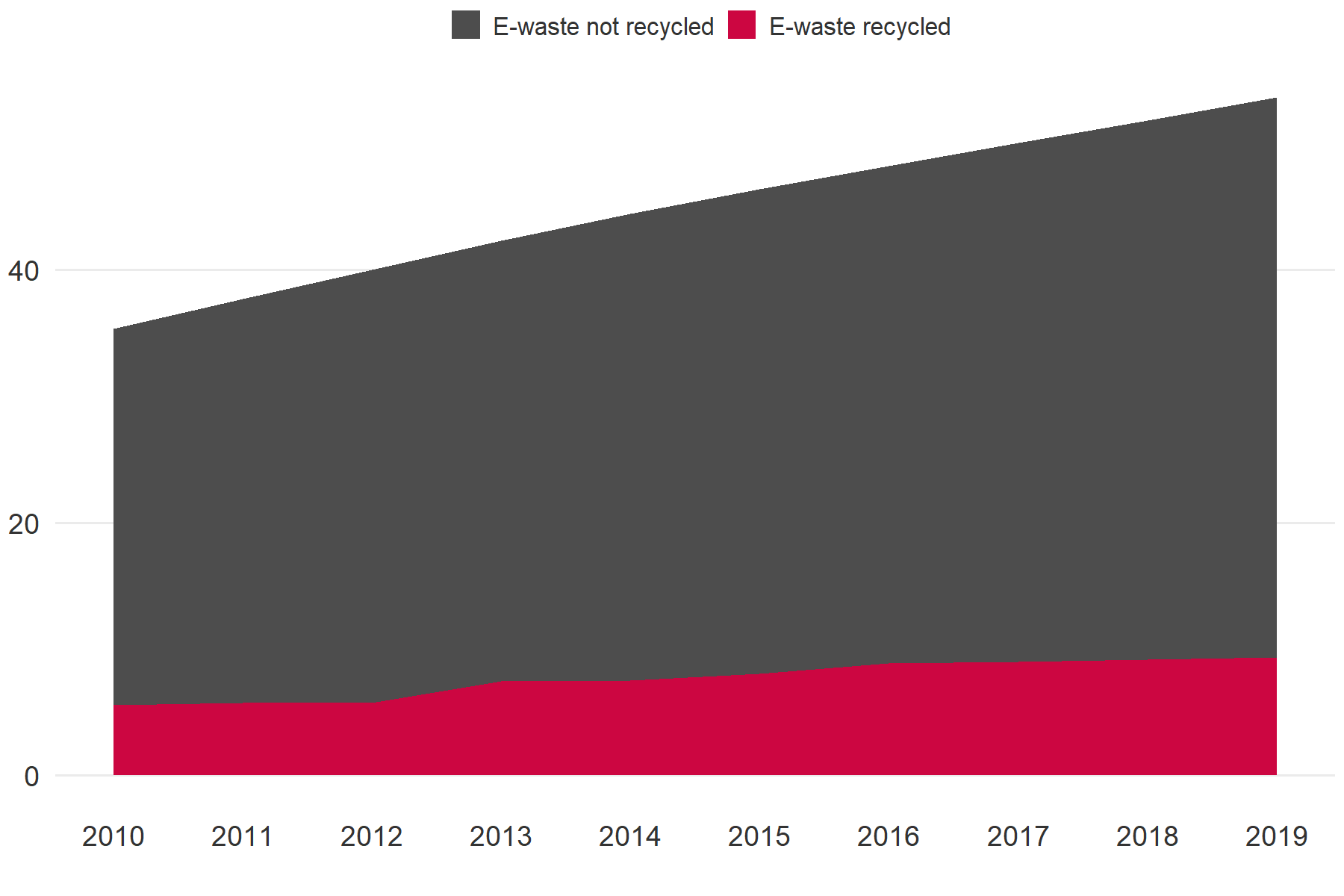


Responsible consumption and production
Managing plastic and food waste for a sustainable future
SDG 12 recognizes that long-term development and economic growth depend on changing how we produce and consume goods. It demands more efficient and environmentally friendly management of materials across the lifecycle, through production, consumption, and disposal. This includes some critical and ambitious targets laid out by the SDG framework—for example, improving how we use and dispose of materials such as minerals, fossil fuels, and metals (SDG target 12.2), reducing food loss at all stages of the food supply chain (SDG target 12.3), and minimizing plastic waste (related to SDG target 12.5), which pervades the natural environment.
Total materials use is expected to increase by about 15 percent by 2030 and by 75 percent by 2060
Global Materials Use, Gigatonnes (Gt)

Minerals
86.23Gt
in 2060
Biomass
37.11
Fossil fuels
24.12
Metals
19.52
2020
2025
2030
2035
2040
2045
2050
2055
2060
Higher economic growth and income per capita combined with projected population growth of 3 billion by 2050 are expected to increase materials use. Global materials use is expected to increase by 15 percent by 2030 and by 75 percent by 2060, to 167 billion metric tons. Growth in low- and middle-income economies aspiring to match the standard of living in high-income economies could be a substantial driver of material consumption. Without targeted structural or technological policies to curb resource consumption or promote recycling, materials use will expand unabated. This will likely have negative consequences for the environment, due to material extraction as well as pollution from subsequent waste.
Food waste and plastics together make up more than half of global waste
Share of global waste (%), 2018

44%
Food and green
5%
Glass
4%
Metal
12%
17%
Plastic
Paper and
cardboard
14%
Other
Rubber, leather
Wood
Source: What a Waste 2.0: A Global Snapshot of Solid Waste Management to 2050 (World Bank)
Waste is an inevitable byproduct of societies that create and consume goods. In 2016 more than 2 billion metric tons of waste was generated globally, with each person contributing on average 0.74 kilogram per day. More than half of global waste is from food and plastic; other major waste categories are paper and cardboard, glass, metal, rubber, leather and wood.
In poorer countries most food loss happens at the production and distribution stages, while in richer countries most loss is at the consumption stage
Share of total food at each stage of the food supply chain (%)

Production
Handling and Storage
Processing
Consumption
Distribution
WASTE
74.0% left
South and Southeast Asia
Industrialized Asia
68.7
Europe
66.0
Latin America
66.0
65.0
North America and Oceania
Sub-Saharan Africa
64.0
North Africa, West and
Central Asia
63.6
0%
20
40
60
80
100
Source: Reducing Food Loss and Waste: Setting a Global Action Agenda (World Resources Institute)
The food supply chain is the pathway by which food moves from farms to our plates. Food is produced, stored, processed, and distributed before being sold by retailers to consumers. Food loss refers to food intended for human consumption that leaves the food supply chain between being produced and reaching a retailer. The most common causes of food loss are damage during harvesting, loss during storage due to unsuitable temperatures, and humidity or infestation. Food waste refers to food that is discarded by retailers or consumers—for instance, because it has reached its “best by” date or as a result of spoilage.
The amount of food loss and food waste at various stages of the food supply chain differs by region. Food waste is particularly noticeable in North America, where 10 times more food is lost at the consumption stage than in Sub-Saharan Africa and Europe. In contrast, most food loss in low- and middle-income economies is at the handling and storage stages because many of these countries lack the infrastructure to properly store food.
Food loss during production is a global issue, irrespective of region or income level. A third of food loss occurs at the production stage in many economies. The COVID-19 pandemic has heavily disrupted global supply chains, which may worsen production losses. For instance, the lockdowns implemented in many countries to prevent the spread of the disease have affected restaurants’ ability to sell the food they have bought. That food may be wasted if it is not redirected to food banks or grocers. However, higher food costs and uncertainties in food supply chains may generate new momentum among consumers to curb food waste.
Reducing food loss and food waste is crucial to ending hunger. More than 1.3 billion metric tons of food is wasted every year while almost 2 billion people go hungry or are undernourished. To meet SDG target 12.3, economies need to focus on strategies for the stages of the food supply chain with the greatest losses, such as producing more usable food with the same amount of resources or providing farmers’ access to better storage facilities which can limit the amount of resources needed to produce the world’s food.
Over two-thirds of all plastics ever made have been discarded, and only 6 percent of plastics have ever been recycled
Plastic consumption by stage, Gigatonnes (Gt)

Discarded
Primary Production
Used once
4.6
0.3
8.3Gt
5.8
Incinerated
0.1
0.7
Recycled
0.5
2.5
0.1
Still in use
Source: Geyer, R., Jambeck, J. R., & Law, K. L. (2017). Production, use, and fate of all plastics ever made Science Advances, 3(7)
Plastics account for a fifth of global waste and are coming under increasing environmental scrutiny. Although large-scale production of plastics did not start until the 1950s, plastics are now part of everyday life, from storage containers and packaging to electronics. From 1950 to 2015 more than 8.3 billion metric tons of plastics were produced, and the majority have been used only once. Over two-thirds of all plastics ever made have been discarded, ending up in landfills and contributing to environmental pollution. Only 6 percent of plastics have ever been recycled.
The COVID-19 pandemic has boosted plastic consumption. Single-use plastics such as masks, personal protective equipment kits, and sanitizer bottles have been deemed essential to managing the spread of the disease. Globally, the sale of disposable face masks has increased by a factor of 200—from 800 million in 2019 to 166 billion in 2020—resulting in a staggering increase in plastic waste. In addition, with lockdown and social distancing measures in many countries, households worldwide have resorted to deliveries of food, packages, and other necessities—another cause for increase in plastic waste. In Thailand plastic waste has increased from 1,500 tons a day to 6,300, presumably because of a sharp increase in food deliveries. With 75 percent of plastic waste either clogging landfills or floating in the seas, responsibly consuming and disposing plastic waste are critical for protecting lives on land (SDG 15) and below water (SDG 14).
Responsible consumption and production of plastics can be realized through better strategies for plastic production and waste management. Some of the most common strategies in plastic production are dematerialization, substitution, and enhanced biodegradability. For better plastic waste management, an effective after-use plastics economy needs to be built with efficient collection and reprocessing to reduce leakage into natural systems. Tunisia’s successful waste management strategy introduced an extended producer responsibility scheme: individuals and informal waste collectors were given monetary incentives to gather plastic waste and deliver it to collection centers. In addition to raising plastic recycling rates, the scheme created jobs and micro-enterprises.
More investment is also needed in waste management, particularly in low-income economies, where plastic production and consumption will grow most. Stronger recycling value chains and better financial efficiency of solid waste management are key to ensuring that systems improve. Governments can also help reduce plastic waste by banning or taxing single-use plastic products or packaging and providing other regulatory oversight.
A recent study presents three future scenarios for global plastic waste generation and disposals:
Mismanaged plastic waste: Estimates for now and the future
Amount of plastic waste, Metrictonnes (Mt)
Source: Lebreton, L. & A. Andrady. (2019). Future scenarios of global plastic waste generation and disposal. Palgrave Communications, 5(6)
SCENARIO A: Business as usual. Based on growing demand, global mismanaged plastic waste nearly triples by 2060, from 80 metric tons a year to 213.
SCENARIO B: Improved waste management. With waste management infrastructure gradually improved, particularly in developing countries, global mismanaged plastic waste decreases to 50 metric tons a year by 2060.
SCENARIO C: Reduced plastic use and improved waste management. Waste management efforts improve as in Scenario B, and plastic waste in households is halved to 5 percent of municipal solid waste by 2040.
Before the COVID-19 pandemic, both governments and corporations were attempting to reduce plastic waste. In 2019 more than 180 countries signed on to an update of the UN 1989 Basel Convention to include plastic as a hazardous waste, and industries worldwide pledged to increase recycled plastic in packaging to 22 percent by 2025. As plans develop to recover from COVID-19, countries have an opportunity to “reset the clock” and further their commitment of reducing plastic and food waste.
Learn more about SDG 12: Responsible consumption and production
Swipe for the next chart


Notes
- Kaza, Silpa, Lisa C. Yao, Perinaz Bhada-Tata, and Frank Van Woerden. 2018. What a Waste 2.0: A Global Snapshot of Solid Waste Management to 2050. Urban Development Series. Washington, DC: World Bank. ↩
- Food and Agriculture Organization. Food loss and waste during COVID-19 pandemics: useful readings./ ↩
- Ladd, Jenn, and Aubrey Whelan. 2020. As Philly Restaurants Shutter, Massive Amounts of Food Are at Risk of Going to Waste. Here’s How to Help. The Philadelphia Inquirer, March 16. ↩
- Food and Agriculture Organization. Food loss and waste during COVID-19 pandemics: useful readings. ↩
- Food and Agriculture Organization. 2019. The State of Food and Agriculture 2019: Moving Forward on Food Loss and Waste Reduction. Rome. ↩
- Kaza, Silpa, Lisa C. Yao, Perinaz Bhada-Tata, and Frank Van Woerden. 2018. What a Waste 2.0: A Global Snapshot of Solid Waste Management to 2050. Urban Development Series. Washington, DC: World Bank. ↩
- Geyer, R., Jambeck, J. R., & Law, K. L. (2017). Production, use, and fate of all plastics ever made Science Advances, 3(7) ↩
- United Nations Conference on Trade and Development. Growing plastic pollution in wake of COVID-19: how trade policy can help July 27, 2020. ↩
- World Economic Forum The plastic pandemic is only getting worse during COVID-19 ↩
- United Nations Conference on Trade and Development. 2019. Advancing Sustainable Development Goal 14: Sustainable Fish, Seafood Value Chains, Trade and Climate. Geneva. ↩
- Kaza, Silpa, Lisa C. Yao, Perinaz Bhada-Tata, and Frank Van Woerden. 2018. What a Waste 2.0: A Global Snapshot of Solid Waste Management to 2050. Urban Development Series. Washington, DC: World Bank. ↩
- Ellen MacArthur Foundation and United Nations Environment Programme. 2019. The New Plastics Economy Global Commitment 2019 Progress Report Basel Convention. n.d. “Basel Convention Plastic Waste Amendments.” Basel Convention Website, May 2019 ↩
- Organisation for Economic Co-operation and Development. 2019. Global Material Resources Outlook to 2060. Paris. ↩











